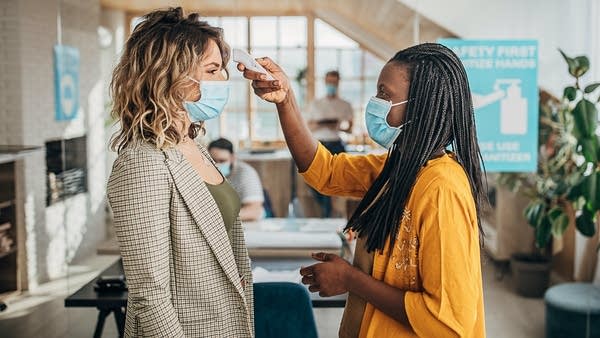When will there be enough herd immunity to return to the workplace?
For COVID-19, predictions of what it will take to reach herd immunity vary wildly, and it’s more complicated than one magic number.

New York’s Mayor Bill de Blasio has decided that as of May 3, all city municipal workers will be required to report to work – in person, according to the New York Times. That’s about 80,000 employees who have been working remotely for a year. Face masks and social distancing are advised. But with new COVID-19 variants and many people unvaccinated, there are still a lot of questions about when exactly is it the right time to bring America back to the workplace.
There’s been a lot of talk about needing to achieve herd immunity. In epidemiology, that’s the point at which enough people are immune to a disease that it can no longer easily spread, effectively protecting the whole population. If we can just hit that number, businesses, in fact the country at large, could know it’s safe to reopen.
The problem is, it isn’t a magic number, and it isn’t just one number at all. According to Dr. Samuel Scarpino, who directs the emergent epidemics lab at Northeastern University, “small changes in your assumptions, small changes in the way the disease is actually spreading in the population, lead to wildly different possible trajectories.”
For COVID-19, predictions of what it will take to reach herd immunity vary wildly. By some estimates, only 15% of people need to be immune, other estimates say 90%, according to Scarpino. That range is so huge because herd immunity is a calculation. And part of the math in there is about how the virus spreads.
So, Scarpino said, anything that changes how the virus spreads will change your answer. “For example the herd immunity threshold for a population wearing masks and engaging in some measure of physical distancing is very different from one that is not doing either one of those things.”
And all of this means – there won’t be just one moment or one benchmark for when a given office can reopen. “Every building is different, and every workplace and procedures are different so you have to make your own plan for sure,” explained Dr. Gigi Gronvall, a senior scholar at the Johns Hopkins Center for Health Security.
This ambiguity around when to bring people back to work is something employers are starting to digest. They’re going to have to figure out for themselves what to do.
“It’s going to depend on the area in which the business is located,” said Amber Clayton, director of the knowledge center at the Society for Human Resources Management or SHRM. “The employer’s going to want to follow state, local laws that pertain to businesses, they’ll also want to look at the COVID cases within their particular areas,” she said.
Another issue is how the employees themselves feel.
To determine that, Christopher Gavigan, founder of Prima, a plant-based health and wellness company, said, “we’ve run polls.”
Prima, like many companies, is trying to take the pulse of their workforce. They have found, “it ebbs and flows, world events, on the realities with this pandemic.”
So if employee comfort is one of the main issues, one of the obvious actions that will make a lot of employees feel comfortable is getting the vaccine. So, Gavigan said, “based on what we know I think we will require it.”
Legally, employers can mandate employees get vaccinated, according to Karen Elliott, a partner who specializes in labor and employment law at Eckert Seamans Law firm in Richmond, Virginia. But, she said, “with a caveat of religion and ADA concerns.” In other words, people can refuse a vaccination on religious or disability grounds.
In addition, Clayton with SHRM said that, “some states have actually proposed legislation to not allow employers to require vaccination. Right now our research shows that more employers are encouraging it rather than requiring it.”
As of January, only around 5% of employers were going to require the vaccine, according to SHRM’s survey, 35% were unsure, and 61% were not going to require it. Those numbers may change.
And even if employers do bring people back to the office, that doesn’t mean back to normal. There may still be safety rules around COVID-19, said Laura Stock, director of the Labor and Occupational Health Program at UC Berkeley. “Which,” she added “might mean ensuring that everyone wears a mask inside, that physical distancing is possible, that sanitation is occurring, that schedules are adjusted so there’s not everybody taking lunch at the same time.”
She said we really are going to still be doing this even when vaccinated. “A lot of these recommendations are going to be changing but I think we have a ways to go before we can throw these recommendations out.”
Which is all to say, the world of work changed almost overnight back in March of 2020. It will take much longer to go back to normal, whatever normal now means.













